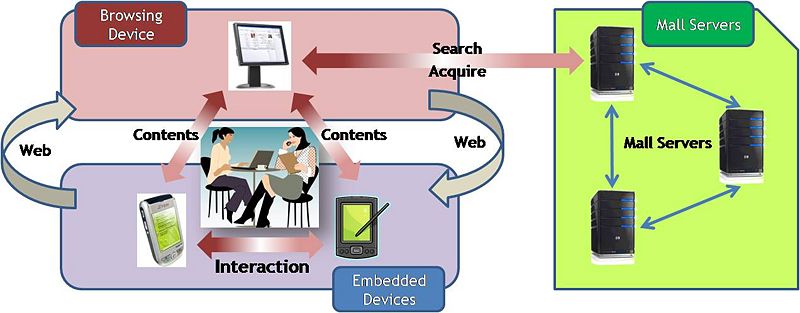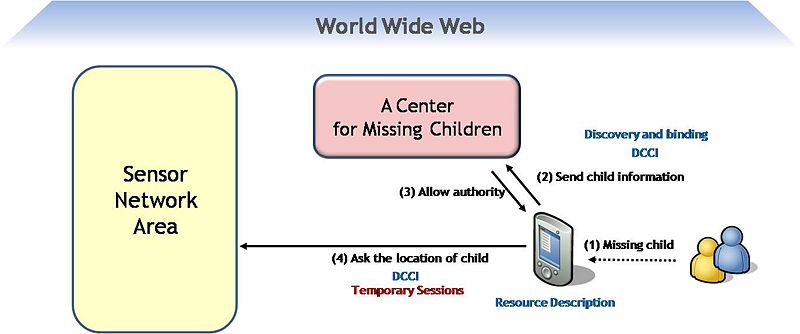Warning:
This wiki has been archived and is now read-only.
Device coordination
Device Coordination: Terminology and Use Case
Contents
Introduction
A wide diversity of devices with an increasing range of capabilities is obtaining the ability to access the Web. Web enables the devices to provide several services by means of Web applications. Furthermore, services are becoming more rich and useful in a form of adapted services considering user intents and context that can be recognized or inferred from surrounding devices and sensors. For the ultimate ubiquitous Web, there are several aspects to be considered.
- First, it is necessary to describe resources in terms of device capabilities, limitations, and usage configurations, to name a few, in order for them to be utilized in an effective manner.
- Second, mechanisms for resource discovery and binding applications to the discovered resource need to be constructed.
- Third, communications among devices with needed resources for a service need to be facilitated.
- Fourth, it is necessary to obtain and process the information about user preferences, device capabilities, and environmental conditions for detecting user intent and/or delivery context.
- Fifth, service sessions are to be considered when resources are bound in the context of application sessions since a session may be temporary or persistent depending on characteristics of services or interactions with users.
- At last but not the least, it is desirable to coordinate devices for providing compound services, to cluster resources based on their relevancies for an efficient discovery and binding mechanism, and to manage users’ accessibility to certain types of resources in accordance with users’ privilege or authority.
Terminology
Regarding on the device coordination, there is no exact definition(e.g wikipedia[1], google[2]).
In the dictionary, the each word has the following meaning.
- Device is a machine used to perform one or more relatively simple tasks
- Cordination is the act of coordinating, making different people or things work together for a goal or effect
But, regarding on the “device coordination”, everyone has their own view on device coordination like follows.
- Accessing a device using Web technologies
- Messaging between devices as a means to coordinate activities
- means for discovering and binding of resources into application sessions
- etc
So, for the develop the specification on device coordination such as vocabulary on device coordination, extended the current specification, making the scenario or use case on device coordination, it is required to make the common definition on the device coordination
- Device Coordination is “xxx” (TBD)
Scope
Device coordination considers resource description, discovery and binding, communications between devices, delivery context client interfaces, temporary and persistent sessions, etc. Then, the most of related considering points was already started in W3C
- Resource Descriptions: In order to discover resources and recognize their usage and device capabilities, it is necessary to describe resources. Devices and services can be identified by URIs. RDF provides the basis for such descriptions, while OWL provides a means to express ontology for the properties and relationships used in these descriptions.
- Discovery and Binding: Discovery and binding is the process of describing users’ needs and searching for a matching resource in order to provide services adapted to delivery context and/or user intents.
- Communication between Devices: In order to provide the user with adapted services, communication among devices is important. It may be possible to interact between devices by targeting an event at a DOM node expressing the device. For example, if web application wants to adjust the printer configuration it can do so by sending an event to a DOM node representing the printer.
- Delivery Context Client Interfaces: DCCI is the interfaces that provide the information related to user preference, device capabilities, and environmental condition for detecting delivery context and/or user intents. DCCI is extended from the document object model, and such resources are exposed as objects in the DOM. The DOM object can act as proxies for adjusting the resources.
- Temporary and Persistent Sessions: Sessions may be temporary, for example, only lasting for the lifetime of a Web page, or permanent, such as for meeting rooms, which applications can join and leave. Sessions are resources in their own right and identified by a URI.
Use Case
Case 1.
- A user finds her favorite shoes at a shoe store in a mall. She obtains information by reading the RFID tag attached to the shoes with her personal device. Basic information (e.g., price, some product information, and recommendations) can be stored in the device. In this way, the user can acquire information on all her favorite shoes throughout the mall.
- The user meets her friends and goes to a cafe. They each transfer acquired information from their personal devices to a large-screen display device on the table via the cafe’s network. They can then compare information regarding their favorite shoes. Related content is searched for in the mall databases and on the Internet, and then the information acquired from the various sources is compared.
Case 2.
- After a meeting in a company, a PDA updates the task information assigned to a user into a task management program in a notebook.
- The task management searches data related to the new task.
- When the task management needs hard copy documents, it transfers the data to a printer and the printer prints documents.
Case 3.
- The task management perceives that the user will have a business trip next week.
- The task management reserves the hotel and the flight in accordance with user’s preference and pays the fee for the accommodation and a flight.
Case 4.
- A user wants to locate his/her child in the theme park. The user’s PDA reports the information about the child to a center for missing children.
- Fortunately, the child wears a watch with RFID. The center can allow the user to access sensory data with his/her PDA that are collected from sensors scattered around the park.
- The user’s PDA identifies the location of his/her child.
References
- Alistair Coles, Eric Deliot, Tom Melamed, and Kevin Lansard, “A Framework for Coordinated Multi-Modal Browsing with Multiple Clients,” Proceedings of the 12th international conference on World Wide Web WWW '03, 2003. [3]
- Oscar Ardaiz, Pau Artigas, Torsten Eymann, Felix Freitag, Roc Messeguer, Leandro Navarro and Michael Reinicke, “Exploring the Catallactic Coordination Approach for Peer-to-Peer Systems,” Lecture Note in Computer Science, Vol. 2790, 2004.
- Yutaka Kidawara, Tomoyuki Uchiyama, and Katsumi Tanaka, “An Environment for Collaborative Content Acquisition and Editing by Coordinated Ubiquitous Devices,” Special interest tracks and posters of the 14th international conference on World Wide Web WWW '05, 2005 [4]
Related Patents
- Coordination of communication with devices [5]
Question and Answer
(TBD)
- What is difference between device coordination and service coordination on device
- What is difference between coordination and integration?
- How to identifies/expose the device capabilities and service capabilities?
- How to search the capabilities?
- How to binding/interact with services/devices?
- What is coordination operation?
- How to maintain the status of application in Ubiquitous Web environment?
- Is it required to rebuild the current Web applications for device coordination?
- How to maintain the session information?
- Hand-off is required?
- Constant connectivity to services by transferring a connection from one provider to another.
- How to include the sub-network resources such as UPnP, Jini, Havi, etc.?



